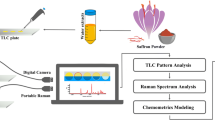Abstract
Commercial enological tannins from various origins have been widely used in modern wine making. In order to investigate the diverse quality of tannin products, a quick, accurate and simple UPLC method was developed, which could simultaneously determine 11 principle characteristic components of hydrolysable tannins and condensed tannins. The optimum resolution of the tannins was achieved on a Waters Acquity UPLC-BEH C18 column (2.1 mm × 50 mm, 1.7 μm) at 280 nm with gradient elution. The method was validated to achieve desired specificity, linearity, precision, accuracy and stability. The developed method was successfully applied to 30 commercial enological tannins from different origins for their quality evaluation. The 30 tannin samples were qualitatively distinguished into hydrolysable, condensed or mixture tannins, and quantificationally classified into four levels of excellent, good, fair and poor products. The method could be used for quick evaluating the quality of enological tannins in practical use.


Similar content being viewed by others
References
Bautista-Ortín AB, Martínez-Cutillas A, Ros-García JM, López-Roca JM, Gómez-Plaza E. Improving colour extraction and stability in red wines: the use of maceration enzymes and enological tannins. Int. J. Food Sci. Tech. 40: 867–878 (2005)
Comandini P, Lerma-García MJ, Simó-Alfonso EF, Toschi TG. Tannin analysis of chestnut bark samples (Castanea sativa Mill.) by HPLC-DAD–MS. Food Chem. 157: 290–295 (2014)
De Rijke E, Out P, Niessen WM, Ariese F, Gooijer C, Udo AT. Analytical separation and detection methods for flavonoids. J. Chromatogr. A. 1112(1–2): 31–63 (2006)
Ghanem C, Taillandier P, Rizk M, Rizk Z, Nehme N, Souchard JP, El Rayess Y. Analysis of the impact of fining agents types, oenological tannins and mannoproteins and their concentrations on the phenolic composition of red wine. LWT Food Sci. Technol. 83: 101–109 (2017)
Giovando S, Pizzi A, Pasch H, Rode K. Synthetic tannins structure by MALDI-TOF mass spectroscopy. J. Appl. Polym. Sci. 114: 1339–1347 (2009)
Kelm MA, Johnson JC, Robbins RJ, Hammerstone JF, Schmitz HH. High-performance liquid chromatography separation and purification of cacao (Theobroma cacao L.) procyanidins according to degree of polymerization using a diol stationary phase. J. Agric. Food Chem. 54: 1571–1576 (2006)
Liu YX, Liang NN, Wang J, Pan QH, Duan CQ. Effect of the prefermentative addition of five enological tannins on anthocyanins and color in red wines. J. Food Sci. 78(1): C25-C30 (2013)
Martínez TF, Moyano FJ, Diaz M, Barroso FG, Alarcon FJ. Ruminal degradation of tannin-treated legume meals. J. Sci. Food Agr. 84: 1979–1987 (2004)
Mämmelä P, Savolainen H, Lindroos L, Kangas J, Vartiainen T. Analysis of oak tannins by liquid chromatography-electrospray ionisation mass spectrometry. J. Chromatogra. A. 891(1): 75–83 (2000)
Neves AC, Spranger MI, Zhao Y, Leandro MC, Sun B. Effect of addition of commercial grape seed tannins on phenolic composition, chromatic characteristics, and antioxidant activity of red wine. J. Agric. Food Chem. 58: 11775–11782 (2010)
Niola F, Basora N, Chornet E, Vidal PF. A rapid method for the determination of the degree of N-acetylation of chitin-chitosan samples by acid hydrolysis and HPLC. Carbohyd. Res. 238: 1–9 (1993)
Pizzi A, Pasch H, Rode K, Giovando S. Polymer structure of commercial hydrolyzable tannins by matrix-assisted laser desorption/ionization-time-of-flight mass spectrometry. J. Appl. Polym. Sci. 113: 3847–3859 (2009)
Parker M, Smith PA, Birse M, Francis IL, Kwiatkowski MJ, Lattey KA, Liebich B, Herderich MJ. The effect of pre- and post-ferment additions of grape derived tannin on Shiraz wine sensory properties and phenolic composition. Aust. J. Grape Wine Res. 13(1): 30–37 (2007)
Romer FH, Underwood AP, Senekal ND, Bonnet SL, Duer MJ, Reid DG, Jan HVDW. Tannin fingerprinting in vegetable tanned leather by solid state NMR spectroscopy and comparison with leathers tanned by other processes. Molecules 16: 1240–1252 (2011)
Sanz ML, Martínez-Castro I, Moreno-Arribas MV. Identification of the origin of commercial enological tannins by the analysis of monosaccharides and polyalcohols. Food Chem. 111: 778–783 (2008)
Schofield P, Mbugua DM, Pell AN. Analysis of condensed tannins: a review. Anim. Feed Sci. Tech. 91(1): 21–40 (2001)
Vivas N, Augustin M, Lonvaud‐Funel A. Influence of oak wood and grape tannins on the lactic acid bacterium Oenococcus oeni (Leuconostoc oenos, 8413). J. Sci. Food Agr. 80: 1675–1678 (2000)
Vivas N, Bourgeois G, Vitry C, Glories Y, Freitas VD. Determination of the composition of commercial tannin extracts by liquid secondary ion mass spectrometry (LSIMS). J. Sci. Food Agr. 72: 309–317 (1996)
Viriot C, Scalbert A, Du Penhoat CLH, Moutounet M. Ellagitannins in woods of sessile oak and sweet chestnut dimerization and hydrolysis during wood ageing. Phytochemistry 36: 1253–1260 (1994)
Wolfender JL, Ndjoko K, Hostettmann K. The potential of LC-NMR in phytochemical analysis. Phytochem. Analysis 12(1): 2–22 (2001)
Yanagida A, Shoji T, Kanda T. Characterization of polymerized polyphenols by size-exclusion HPLC. Biosci. Biotech. Bioch. 66: 1972–1975 (2002)
Zhang S, Cui Y, Li L, Li Y, Zhou P, Luo L, Sun B. Preparative HSCCC isolation of phloroglucinolysis products from grape seed polymeric proanthocyanidins as new powerful antioxidants. Food Chem. 188: 422–429 (2015)
Acknowledgements
This work was supported by Program for Liaoning Excellent Talents in University (LJQ2015106), and Scientific Research Foundation for the Returned Overseas Scholars of Shenyang Pharmaceutical University (GGJJ201606).
Author information
Authors and Affiliations
Corresponding author
Ethics declarations
Conflict of interest
The authors have declared that they do not have any conflict of interest.
Ethical review
This study does not involve any human or animal testing.
Informed consent
Written informed consent was obtained from all study participants.
Additional information
Publisher's Note
Springer Nature remains neutral with regard to jurisdictional claims in published maps and institutional affiliations.
Rights and permissions
About this article
Cite this article
Yu, W.C., Li, Z., Sun, B.S. et al. A quick, accurate and general ultra performance liquid chromatography method for evaluating the quality of enological tannins. Food Sci Biotechnol 29, 1045–1052 (2020). https://doi.org/10.1007/s10068-020-00752-4
Received:
Revised:
Accepted:
Published:
Issue Date:
DOI: https://doi.org/10.1007/s10068-020-00752-4




